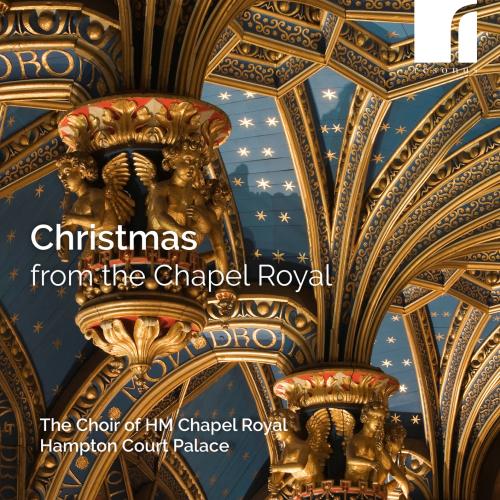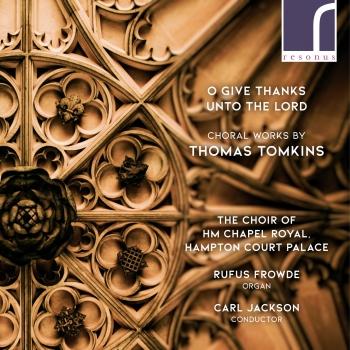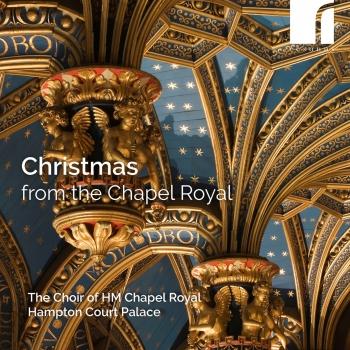
Christmas from the Chapel Royal The Choir of HM Chapel Royal, Hampton Court Palace, Rufus Frowde & Carl Jackson
Album Info
Album Veröffentlichung:
2023
HRA-Veröffentlichung:
24.10.2023
Label: Resonus Classics
Genre: Classical
Subgenre: Choral
Interpret: The Choir of HM Chapel Royal, Hampton Court Palace, Rufus Frowde & Carl Jackson
Komponist: Paul Hindmarsh, Ross Edwards (1943-)
Das Album enthält Albumcover Booklet (PDF)
- Vasyl Barvinsky (1888 - 1963): Shcho to za predïvo:
- 1 Barvinsky: Shcho to za predïvo 02:29
- Martin Hindmarsh (b. 1952): Of a Rose Sing We:
- 2 Hindmarsh: Of a Rose Sing We 02:59
- Andrew Carter (b. 1939): Angelus ad virginem:
- 3 Carter: Angelus ad virginem 03:16
- David Willcocks (1919 - 2015): God rest you merry, gentlemen:
- 4 Willcocks: God rest you merry, gentlemen 03:16
- Paul Edwards (b. 1955): No Small Wonder:
- 5 Edwards: No Small Wonder 02:41
- Rufus Frowde (b. 1978): Adam Lay Ybounden:
- 6 Frowde: Adam Lay Ybounden 02:10
- Stephen Jackson (b. 1951): Noël nouvelet:
- 7 Jackson: Noël nouvelet 04:51
- Philip Moore (b. 1943): Variations:
- 8 Moore: Variations: Noël nouvelet 05:52
- Rufus Frowde: Joyful and Triumphant (Fanfare on ‘Adeste fideles’):
- 9 Frowde: Joyful and Triumphant (Fanfare on ‘Adeste fideles’) 01:34
- John Francis Wade (ca. 1711 - 1786): O Come, All Ye Faithful:
- 10 Wade: O Come, All Ye Faithful 03:34
- George McPhee (b. 1937): Whence is that Goodly Fragrance Flowing?:
- 11 McPhee: Whence is that Goodly Fragrance Flowing? 02:59
- William Mathias (1934 - 1992): A Babe is Born, Op. 55:
- 12 Mathias: A Babe is Born, Op. 55 03:21
- Denis Bédard (b. 1950): Variations sur ‘In dulci jubilo’:
- 13 Bédard: Variations sur ‘In dulci jubilo’ 07:08
- Francis Grier (b. 1955): The Christmas Rose:
- 14 Grier: The Christmas Rose 04:01
- I Saw a Stable:
- 15 Grier: I Saw a Stable 01:11
- Moonless Darkness:
- 16 Grier: Moonless Darkness 01:45
- Martin Hindmarsh: Three Kings of Orient:
- 17 Hindmarsh: Three Kings of Orient 04:46
- Louis Halsey (b. 1929): Coventry Carol:
- 18 Halsey: Coventry Carol 02:52
- Andrew Smith (b. 1970): Veni Emmanuel:
- 19 Smith: Veni Emmanuel 04:02
- William Harold Ferguson (1874 - 1950): From the Eastern Mountains:
- 20 Ferguson: From the Eastern Mountains 02:31
Info zu Christmas from the Chapel Royal
Der Choir of HM Chapel Royal, Hampton Court Palace baut auf der Tradition seiner historischen Vorfahren auf, neue Kirchenmusik zu schaffen, und präsentiert ein Programm mit Musik für Advent, Weihnachten und Dreikönigstag, das sieben Erstaufnahmen sowie Neuinterpretationen von etablierterem Repertoire enthält, das im musikalischen Erbe des Palastes verankert ist.
Das Album enthält Musik von Komponisten wie Philip Moore, Andrew Carter, William Mathias, Martin Hindmarsh, David Willcocks und Francis Grier.
Der Chor der königlichen Kapelle von Hampton Court Palace
Rufus Frowde, Orgel
The Choir of HM Chapel Royal
The mission of the music in the Chapels Royal, HM Tower of London, is to adorn and enrich the liturgy, by working in tandem with and complementing the varied characters of the Church’s seasons. The aim is to assist and deepen the congregation’s understanding and appreciation of the liturgical themes throughout the church year, and through this spiritual dance with the rich liturgy of the Book of Common Prayer, aspire to sublimity and the transcendental.
Music, and musical performance must be of the highest level to achieve this, and this is the constant pursuit of the musicians who work in the Tower chapels. In his television series Music and Monarchy, the historian and television presenter David Starkey reminds us – “On the eve of the Battle of Agincourt, Henry V didn’t have anxious conferences or do rousing talks to the troops. He had a Mass, and not any old Mass, but one magnificently sung and performed. His choir is an armament – the heavenly host have got to fight for you. One lot of artillery batters the gates of Harfleur, and the other lot batters the gates of heaven.”
Making this series, Starkey said, helped him to see why the piety of successive English monarchs prompted them to make such a huge investment in music - “The music is deployed as kind of national juju, a national magic…” The investment has meant that for hundreds of years this musical magic has been part of the religious life of the chapels in the Tower of London.
“Chapel Royal” is something of a misnomer. The term did not originally refer to a building, but rather to an establishment, which was made up of a body of priests and musicians, who, with the rest of the court, travelled with the Sovereign to serve their spiritual needs. Over time, the term became slowly, but increasingly, associated with churches and chapels – the actual bricks and mortar - used by monarchs for worship, and two of these chapels are in the Tower of London.
The first records of the Scottish Chapel Royal date from the eleventh century and it wasn’t until 1501that James IV of Scotland established a building for the Chapel Royal in Stirling Castle. The English Chapel Royal had also emerged as a distinct body by the eleventh century. Records of the Dean of the Chapel Royal date to 1312, and the first full description of the chapel, describing twenty-six chaplains and clerks, comes from the fifteenth century, during the reign of Edward IV. The English Chapel Royal became more and more associated with Westminster Abbey, so that by 1625 over half of the Gentlemen of the English Chapel Royal were also members of the Westminster Abbey choir.
In the seventeenth century the Chapel Royal had its own building in the Palace in Whitehall, and the organ case that now stands in the Chapel Royal of St Peter ad Vincula within the Tower was originally built for that chapel. The Master of the Children had, until at least 1684, the power to pinch promising boy trebles from provincial choirs for service in the chapel and the theatre company affiliated with the chapel, known as the Children of the Chapel Royal, produced plays at court. In the eighteenth century the choristers sang the soprano parts in performances of Handel's oratorios and other works.
Fine music and many of the finest performers and composers – both home grown and foreign - were long an integral part of the itinerant Chapel Royal. Choirs were often augmented by differing types of instrumentalists, according to the musical tastes of the time. Musically speaking, it can be said that the Chapel Royal achieved its greatest eminence during the reign of Elizabeth I, when many composers, including William Byrd and Thomas Tallis, were members, and produced some of the finest music – both sacred and secular - ever to emanate from these shores. It is possible, though we don’t know for certain, that these towering musical figures visited, and perhaps even performed, in the Tower’s two intimate chapels. Nowadays, however, their music is kept very much alive through its regular inclusion at chapel services.
Today, each Chapel Royal and Royal Peculiar boasts its own choir. In 1965, when the last garrison left the Tower, and the future of the chapel seemed unclear, the Tower authorities agreed that services in the chapels should be accompanied by music of the highest quality, and a public appeal was launched for a Choral Foundation to provide a professional Master of Music, organist and choir. Patrons of the successful appeal included the Lord Mayor of London and the Master of the Queen’s Music, and John Williams, who had been an assistant to Herbert Howells at St John’s College, Cambridge, was appointed ‘to form and train a suitable choir’. The first choristers were largely recent graduates of Oxbridge colleges and of London music colleges and, during Williams’ tenure as Master of Music, the choir gave recitals in London and, further afield, featured in many City of London Festivals. They broadcast on both radio and television, and made a much-acclaimed record. In addition, Williams created a broad ranging library of repertoire to be sung in the chapels, and commissioned many contemporary composers to write for the choir. John Williams left the post in 1988, and his legacy is still felt today.
By the late 1990s it was clear that the organ in the chapel needed to be rebuilt or replaced. After considering the requirements of a new organ – an instrument that could lead the congregation, accompany the choir and play as much of the solo repertory as possible with integrity - it was decided to commission a new organ from Orgues Létourneau of Quebec. The organ case was shipped to Canada for renovation, and along with a brand new organ to fit in the reconstructed case, it was returned to the Tower and reassembled in the chapel. The costs were met through a public appeal by the chapel’s Association of Friends.
John Williams was succeeded as Master of Music by Joseph Sentence (1988-94) and Stephen Tilton (1994-2004), both of whom continued and developed the tradition and ethos established by Williams with élan. Today the choir today boasts twelve distinguished professional singers who are led by the Master of Music, Colm Carey, and the Assistant Master of Music, Christian Wilson.
Individual members of the choir sing also for major concert groups including The Monteverdi Choir, The Sixteen, Stile Antico and Tenebrae. Many have independent careers as soloists and can be heard on concert platforms around the globe. As well as singing the liturgical cycle of services for the chapels in the Tower each year, the choir can be heard regularly in concert. It has toured to South Africa, Italy and Ireland, and has been broadcast on several occasions, most notably to the entire Commonwealth on Christmas Day, 2011. Its CD – “Exultate Deo” – was acclaimed by critics, and can be purchased here. You can here some of the tracks on the CD here.
In January 2016, the choir celebrated fifty years with a service of thanksgiving at 1100 on Sunday 31 January and two concerts early in February.
Booklet für Christmas from the Chapel Royal








